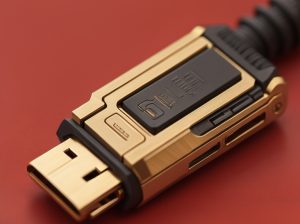
Almost every user, regardless of age or profession, uses USB flash drives in their activities, both professional and personal.
A brief history of the creation
USB flash drives began their journey to popularity in 1984 in Japan. At that time, Toshiba developed a semiconductor flash memory that was rewritable.
However, the invention of the world’s first flash drive belongs to the Japanese Fuji Masuoka. It is known that at that time his company employed 5 people, and it was one of them who created the name of the device.
It was based on the association with the English word “flash,” which means “flash,” since the erasure of information from a medium was accompanied by a flash.
In 1989, the world saw the first chip with NAND flash memory. Its main characteristic was a high density of layout.
The years 1994-1996 are known for the development of the first USB interface standard.
Composition of the USB storage device
Usually, a USB headset consists of several main components, namely:
- A standard USB connector. It is the one she uses to connect to a PC, laptop, and other devices.
- Printed circuit board. It combines a microcontroller with ROM.
- A chip or several chips of flash memory. All information recorded on the device is stored here.
- Quartz generator. It is characterized by increased durability, which allows it to resist dust, dirt and scratches.
How a USB flash drive works
NAND or NOR flash memory is at the heart of every USB flash drive. It contains a silicon crystal. It is on this surface that transistors with floating and controlling isolated gates are located.
When data is being written to the device, a positive voltage is applied to the control gate. Then a part of the electrons moves from the sink to the source. During this movement, they (electrons) are deflected to the floating gate.
After that, some of the electrons are separated and overcome the thin insulator layer, continuing their journey in the floating gate. This is where they remain for a long time.
The main types of flash drives
All flash drives may have different USB specifications: 1:0, 2:0, 3:0, and 4:0. Therefore, the newer the version, the better and higher the data transfer rate, that is:
- USB 1.0 – 12 Mbps;
- USB 2.0 – 480 Mbps;
- USB 3.0, 3.1 Gen 1 and 3.2 Gen 1 – 5 Gbps;
- USB 3.1 Gen 2 and USB 3.2 Gen 2 – 10 Gbps;
- USB 3.2 Gen 2×2 – 20 GB/s;
- USB 4 – up to 40 Gbps.
Most of these devices are characterized by backward compatibility, meaning that if you connect a USB 2.0 gadget to a USB 3.0 port, it will function well, but at the speed of USB 2.0.
Advantages and disadvantages of USB flash drives
Advantages:
- portability, low weight of the device, and quiet operation;
- All modern PCs, laptops, TVs, and other devices have USB slots;
- They can be used in a wide range of temperatures;
- All data recorded on the device can be stored automatically for 5-10 years;
- more resistant to mechanical stress;
- scratch and dust resistant;
- have no moving parts. This reduces energy consumption by several times.
Disadvantages:
- limited number of write-purge cycles;
- sensitive to radiation and electrostatic discharge;
- write and read speeds are limited by the USB bus bandwidth;
- connecting a flash drive on the first try is not always possible due to the asymmetry of the interface when the connector is symmetrical.
Thus, USB flash drives are very convenient to use and provide reliable storage of information data for a long time from 5 to 10 years.

